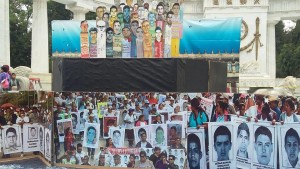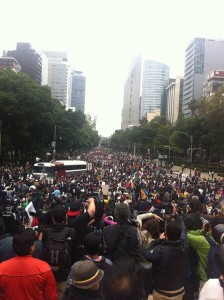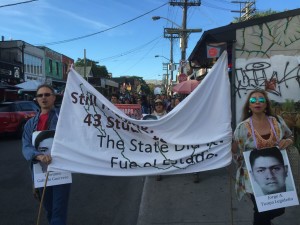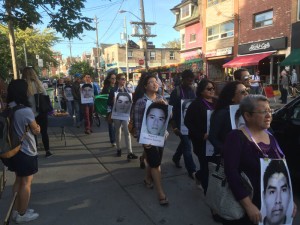
On September 26, 2015, we arrived in Ayotzinapa, Guerrero on the first anniversary marking the forced disappearance of the young students from the rural teachers’ college. The 43 students, who have still not been found, continue to reinforce the idea that the numbers of dead and missing people that increased during Felipe Calderon’s administration (2008-2012) and continue to climb throughout Enrique Peña Nieto’s, are the result of the State’s failed war against narcotrafficking. At the same time, the perception has also been strengthened that the Mexican State uses its security forces against its own youth and innocent citizens. A recently released report prepared by the Interdisciplinary Group of Independent Experts (IGIE) of the Inter-American Commission on Human Rights regarding this case has revealed numerous inconsistencies in the State’s official investigation of the crime, leading the IGIE to recommend that the investigative lines be reformulated, with the transport of narcotic drugs seen as the potential motive in the violent attack against the students. Another recommendation made by the IGIE is that all public officials involved in obstructing the investigation themselves be investigated, including all security forces that were present in the events leading up to the disappearance of the 43 youth.
This new evidence suggests that innocent civilians with absolutely no link to the cartels can today end up victims of the cartels anyway, as well as of the State security forces. Under these conditions, it can be said that Mexicans do not live in peace. The deterioration of calm, which can both be felt and smelled, is now also evident in the internationally recognized indicators of peace. In the Institute for Economics and Peace’s (IEP) recently published 2015 Global Peace Index, for example, Mexico ranks 144th out of a total of 162 countries assessed. Mexico is thus positioned among the world’s least peaceful countries and among the nations of the global community most riddled by violence. Some factors contributing to this low level of peace include political violence, the decomposition of the State’s fabric, State terrorism, and the presence of drugs cartels.

Today, Mexico’s deterioration of peace is reported worldwide: the dead, the murdered, the drug lords ‘escaping’ from jail. Surprisingly, responses from other states are almost non-existent. Even our two amigos under the North American Free Trade Agreement (NAFTA)—the United States and Canada—turn their backs on the Mexican people, silent on what the Mexican State does against them. In stark contrast, other countries ranking higher on the Peace Index, such as Venezuela, are kept under close scrutiny. For Mexicans facing this barrage of violence, it is disappointing that the U.S. Human Rights report of 2014 on Mexico suggests—despite widespread evidence to the contrary—that the Mexican State generally respects freedom of speech and that there is no evidence of political prisoners, politically motivated detentions, or killings authored by State agents.
The line repeated time and again in U.S. and Canadian mainstream media is that Mexico is trapped between local drug cartels and local corruption. As such, the story is reduced to a terror that is purely “Made in Mexico,” powerfully contributing to an imaginary that Mexico and its people are violent and corrupt. It is an easily digestible story, and a very useful one to help justify certain measures against Mexicans, which now include stronger travel restrictions against Mexican nationals. It is precisely what our Canadian amigo has been doing since 2009 with the imposition of new visa requirements, only three years after the number of disappearances and killings began to skyrocket, which had led more Mexicans to begin looking for a place to live in peace; some of them seeking refugee status in Canada once arriving there. Tropes of Mexican corruption were thus subtly used in part to justify and receive public legitimacy for Canada’s new visa restrictions, the argument being that Mexicans abused the system by providing “false evidence” supporting their refugee status claims.

Portraying the violence and corruption in Mexico as a strictly “local” and “Mexican” affair conveniently prevents a deeper digging into its global elements—an especially useful portrayal for states promoting the economic penetration of Mexico, such as the United States and Canada, both of whom have extended their business within Mexico under NAFTA. Particularly striking is the enormous interest shown by US and Canadian mining companies to expand their operations into Mexican territory. Today, 70% of mining companies operating in Mexico are foreign, and from the total of foreign companies, 74% are Canadian-based, while 15% are US-based. Furthermore, a full 30% of Mexican territory is held under concessions controlled by these mining interests. What is astonishing is that foreign direct investment positively grows under the conditions of violence we have seen in recent years. According to a Mining Industry Doing Business in Mexico report, while foreign mining investment only represented 2% of the direct foreign investment in the country in 2006, by 2012 that portion had increased to 36.1%. It is a shift that coincides directly with the most violent years of recent Mexican history!
Mining most often takes place in the countryside; it is also in the countryside where the missing and the dead are most numerous. That Mexico’s climate of violence and insecurity does not negatively affect the business of mining is a fact that is both curious and intriguing. In basic business and finance textbooks, one learns that (excluding illegal activities, such as drug trafficking) business prospers only under contexts of social and economic stability. Yet mining in Mexico has prospered under the very opposite conditions. Perhaps more telling is that there is evidence that mining may actually be causing or exacerbating social and political tensions, the displacement of indigenous communities, and countless cases of environmental damage in the Mexican rural landscape, as pointed out by a report on mining produced by The Commission for Dialogue with the Indigenous Peoples of Mexico [Comisión para el Diálogo con los Pueblos Indígenas de México, CDPIM]. In fact, the arrival of megaprojects has been shown to coincide with forced disappearances and even murderers in many cases. Without a doubt, the dead of recent years may be the faces of miners and activists contesting or opposing those megaprojects. Some such cases are heavily documented, such as the one published in the Britain’s Journal of Critical Legal Thinking on the 2012 murder of a movement leader opposing a mega mining project in Oaxaca, one of Guerrero’s neighboring States. Yet, worldwide, these stories do not make it onto the mainstream media’s headlines.

At the same time that Guerrero has been given the dishonor of being the Mexico’s most violent State, it has also become the country’s new “golden belt.” Some of the companies operating there are Canadian-based, such as GoldCorp Inc. and Newstrike Capital. A study by Garibay and Balzaretti argues that Goldcorp “achieves the political entrapment of the communities, and imposes a micro–regional dominance regime based on coercion” in Guerrero in order to control gold resources. On the other side of the coin, kidnapping and disappearances are today more frequent, a surge that has coincided with the presence of Canadian-based companies. As recently as last February 2015, two employees of a Canadian-based company in Cocula, Guerrero were kidnapped. Violence and gold; mining and drugs—all elements of Guerrero’s landscape, all need to be held together in the story when narrating the landscape of violence and forced disappearances. Indeed, we are speaking of Guerrero, the same state where 43 students of the Isidro Burgos Teachers College in Ayotzinapa went missing a year ago on their way to a political demonstration. Students of a school with a long tradition of political activism, where new generations of indigenous teachers are educated for teaching in Guerrero’s poorest towns. Guerrero, land of guerrilleros, a place of miners, missing people, drug cartels, political and social tension, and of death.
Understanding recent history in this way has inspired action in Canada, from groups and individuals in solidarity with the Mexican people. It is why in the City of Toronto, a group of organizations remembered the 43 students of the Ayotzinapa school on September 26. And by remembering them, we also remember that violence has not only local origins but global ones as well.
Tania Hernandez is a doctoral candidate in the Faculty of Environmental Studies at York University, Toronto, Canada. Dolores Figueroa is a postdoctoral fellow at the Center of Research and Superior Studies in Anthropology, UNAM, Mexico City, Mexico.


